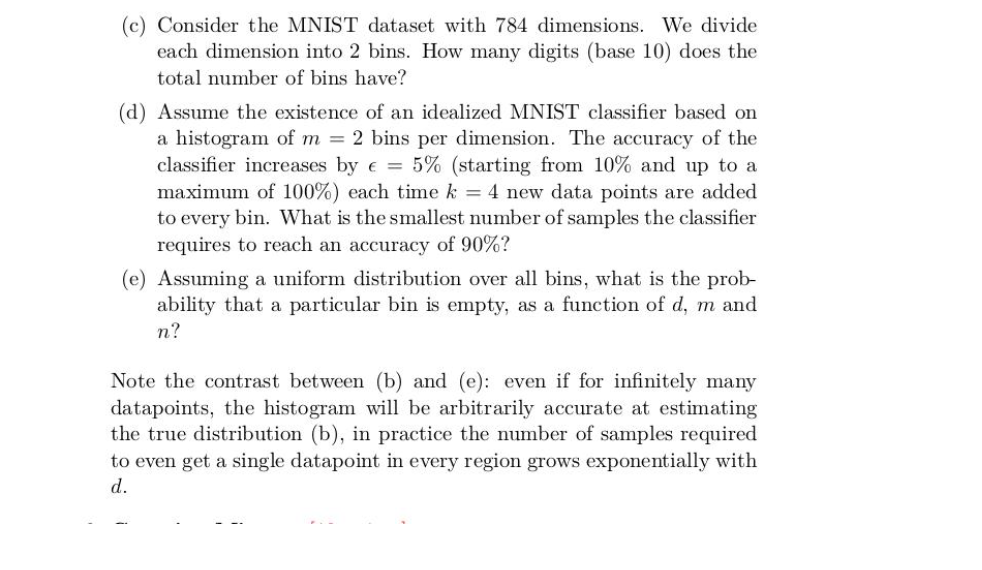(e) Assuming a uniform distribution over all bins, what is the prob- ability that a particular bin is empty, as a function of d, m and n?
(e) Assuming a uniform distribution over all bins, what is the prob- ability that a particular bin is empty, as a function of d, m and n?
MATLAB: An Introduction with Applications
6th Edition
ISBN:9781119256830
Author:Amos Gilat
Publisher:Amos Gilat
Chapter1: Starting With Matlab
Section: Chapter Questions
Problem 1P
Related questions
Question
Hello
solution for question (e) please
Thanks
![Consider a dataset {r;}"-1 where each point r E [0, 1]d. Let f(x) be
the true unknown data distribution. You decide to use a histogram
method to estimate the density f(x) and divide each dimension into
m bins.
(a) Show that for a measurable set S, E[1{resy] = P(r E S).
(b) Combining the result of the previous question with the Law of
Large Numbers, show that the estimated probability of falling in
bin i, as given by the histogram method, tends to fv. f(x)dx, the
true probability of falling in bin i, as n → o. V; denotes the
volume occupied by bin i.
4](/v2/_next/image?url=https%3A%2F%2Fcontent.bartleby.com%2Fqna-images%2Fquestion%2F43c7ed24-8834-4a07-8437-e66dda2ff35c%2F9cad5df0-60df-4e93-96a3-dd28459fef4c%2F4kptxx_processed.png&w=3840&q=75)
Transcribed Image Text:Consider a dataset {r;}"-1 where each point r E [0, 1]d. Let f(x) be
the true unknown data distribution. You decide to use a histogram
method to estimate the density f(x) and divide each dimension into
m bins.
(a) Show that for a measurable set S, E[1{resy] = P(r E S).
(b) Combining the result of the previous question with the Law of
Large Numbers, show that the estimated probability of falling in
bin i, as given by the histogram method, tends to fv. f(x)dx, the
true probability of falling in bin i, as n → o. V; denotes the
volume occupied by bin i.
4

Transcribed Image Text:(c) Consider the MNIST dataset with 784 dimensions. We divide
each dimension into 2 bins. How many digits (base 10) does the
total number of bins have?
(d) Assume the existence of an idealized MNIST classifier based on
a histogram of m = 2 bins per dimension. The accuracy of the
classifier increases by e = 5% (starting from 10% and up to a
maximum of 100%) each time k = 4 new data points are added
to every bin. What is the smallest number of samples the classifier
requires to reach an accuracy of 90%?
(e) Assuming a uniform distribution over all bins, what is the prob-
ability that a particular bin is empty, as a function of d, m and
n?
Note the contrast between (b) and (e): even if for infinitely many
datapoints, the histogram will be arbitrarily accurate at estimating
the true distribution (b), in practice the number of samples required
to even get a single datapoint in every region grows exponentially with
d.
Expert Solution
This question has been solved!
Explore an expertly crafted, step-by-step solution for a thorough understanding of key concepts.
Step by step
Solved in 3 steps with 3 images

Recommended textbooks for you

MATLAB: An Introduction with Applications
Statistics
ISBN:
9781119256830
Author:
Amos Gilat
Publisher:
John Wiley & Sons Inc

Probability and Statistics for Engineering and th…
Statistics
ISBN:
9781305251809
Author:
Jay L. Devore
Publisher:
Cengage Learning

Statistics for The Behavioral Sciences (MindTap C…
Statistics
ISBN:
9781305504912
Author:
Frederick J Gravetter, Larry B. Wallnau
Publisher:
Cengage Learning

MATLAB: An Introduction with Applications
Statistics
ISBN:
9781119256830
Author:
Amos Gilat
Publisher:
John Wiley & Sons Inc

Probability and Statistics for Engineering and th…
Statistics
ISBN:
9781305251809
Author:
Jay L. Devore
Publisher:
Cengage Learning

Statistics for The Behavioral Sciences (MindTap C…
Statistics
ISBN:
9781305504912
Author:
Frederick J Gravetter, Larry B. Wallnau
Publisher:
Cengage Learning

Elementary Statistics: Picturing the World (7th E…
Statistics
ISBN:
9780134683416
Author:
Ron Larson, Betsy Farber
Publisher:
PEARSON

The Basic Practice of Statistics
Statistics
ISBN:
9781319042578
Author:
David S. Moore, William I. Notz, Michael A. Fligner
Publisher:
W. H. Freeman

Introduction to the Practice of Statistics
Statistics
ISBN:
9781319013387
Author:
David S. Moore, George P. McCabe, Bruce A. Craig
Publisher:
W. H. Freeman